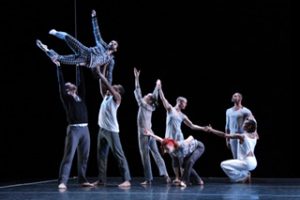Play is Sacred in Bill T. Jones’s “Play and Play”
The word “legendary” gets overused, but the Bill T. Jones/Arnie Zane Dance Company is the real thing. In its thirty-five year history, the New York-based company has become truly legendary for work that addresses big issues head-on, often using theatrical elements as well as dance. In “Last Summer at Uncle Tom’s Cabin/The Promised Land” (1990), Jones (the company’s sole artistic director after Zane died in 1988) took on race, sexual orientation, and faith. To develop “Still/Here” (1994), he did workshops did around the country with people suffering from AIDS and other terminal illnesses. (You can see the moving documentary Bill Moyers made about this project here.)

From “Ravel: Landscape or Portrait?” Photo: Paul B. Goode
There is nothing head-on about “Play and Play,” the program of two relatively recent pieces that the company brought to UCSD’s Mandeville Auditorium on Thursday (presented by Artpower). Set to Ravel and Schubert string quartets—which were given a luscious live performance by the local group Quartet Nouveau—this is exuberant pure dance. Yet this gentler work also offers a profound message … about play as a sacred activity that teaches us how, simultaneously, to be both individuals and members of a community.
The nine dancers romp, scamper, scuffle, and pile on each other. Like leaves in a gusty wind, they form groups and as quickly scatter; but, even as they swirl apart, the sense of interconnection is so palpable, these ravishing movers can seem like a single organism. Still, as one person or another breaks out into a solo (often, while others simply stand and witness), personalities emerge: regal, fierce Rena Butler, quicksilver Jenna Riegel, powerfully leaping Antonio Brown, Carlos Antonio Villanueva’s mischievous trickster energy; at the start of the Ravel piece, Villanueva’s hand gestures seem to conjure the others into life.
Of course, the two dances, like their scores, have different emotional hues. In “Ravel: Landscape or Portrait?” (2012) to the String Quartet in F Major, there’s a gentle innocence, as the dancers—wearing shirts and loose pants in a muted palette of black, white and gray—create an onstage society on their own, with the musicians essentially invisible in the orchestra pit. At one point, a projection with silhouetted vines and leaves covers the stage (as well as some of the audience) and puts them in an enchanted garden. (Janet Wong did the projections. Bjorn Amelan and Robert Wierzel designed, respectively, the decor and lighting.)
Everything heats up in “Story/” (2013), to Schubert’s String Quartet No. 14 in D minor. The musicians are right there onstage, the costumes (though still casual pants and shirts) are brighter, and the music and mood can become turbulent. The dancers suddenly shout “Hey!” or stomp out a rhythm with their feet. Four men tightly cluster, and it’s like plugging into a socket, making them explode into a dramatic tableau. A woman rolls across the stage emitting a cloud of smoke as if she’s on fire!
Still, in both pieces, the knock-around clothes (by Liz Prince) are what my mom used to call playclothes, and even the contentious bits in “Story/” have a sense of fun.
The pieces share something of an inside joke, as well. Though it isn’t mentioned in the program or the press release, the company’s website reveals that both reflect chance operations. For “Ravel: Landscape or Portrait?”, a chance procedure before each performance determines which of two choreographic variations— landscape or portrait—they’ll dance in the third movement. And Jones used a random menu of movement to create “Story/,” which he sees as an homage to “Story/Time,” a work by one of the most playful of 20th century artists, composer John Cage. (Jones talks about it in an interview here.)
Both of the dances in “Play and Play” feel like a window into the same fortunate society, one graced with an understanding of what naturalist/author Diane Ackerman calls “transcendent play,” an activity “akin to rapture and ecstasy, that humans relish, even require to feel whole.”
***
Speaking of transcendent play, while I was doing some Googling, I came across this video of the late physicist Richard Feynman getting very silly on the bongo drums. It has nothing to do with Bill T. Jones’s “Play and Play.” And, on the other hand, they have everything to do with each other.

Award-winning dance journalist Janice Steinberg has published more than 400 articles in the San Diego Union-Tribune, Dance Magazine, the Los Angeles Times, and elsewhere. She was a 2004 New York Times-National Endowment for the Arts fellow at the Institute for Dance Criticism and has taught dance criticism at San Diego State University. She is also a novelist, author of The Tin Horse (Random House, 2013). For why she’s passionate about dance, see this article on her web site, The Tin Horse
